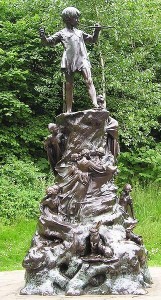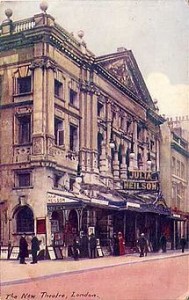Judy Dench and Ben Whishaw, on the stage together, a cast made in Heaven, and me in the front row of the stalls. Bliss.
The chance meeting of elderly Alice Liddell Hargreaves, the real-life inspiration for Alice in Lewis Carroll’s Alice in Wonderland, with 30 year old Peter Llewelyn Davies, one of the five brothers who inspired J.M Barrie’s Peter in Peter Pan, in the Bumpus bookshop in 1932, has been described as the collision between enchantment and reality.
From the moment that playwright John Logan learned that the two had met, he wondered what the real-life Alice and Peter might have said to each other, and out of this germ of an idea grew his play, Peter and Alice, a drama about literary identity theft – the unhappy notoriety gained from being written about in a highly successful literary work.
What did I think of the play, which is at present playing in the Noel Coward Theatre, St. Martin’s Lane?
Well, the acting was superb, as you would expect. The sets were magical, conveying both of the fairy tale worlds in which the fictional Alice and Peter lived out their lives, and the dusty atmosphere of the Bumpus bookshop, which framed the drama. The play, itself, I found a little long, although only 90 minutes (without an interval), which is a fault that I’ve found with several plays in the past few years. A dramatist needs to accept the point at which an idea has run out of steam.
Is there anything in this for a fiction writer, you may well ask.
The answer: two possible story ideas, and a salutary reminder.
First story idea. A meeting of two characters, who have something in common with each other, but who may or may not have met each other in real life. It’s a variation of the ‘What if?’ prompt. That Alice Liddell met Peter Llewelyn Davies is known, but no more than that. The playwright did the rest.
What about you? Can you think of two people, alive or dead, whose meeting and subsequent conversation/actions, would make a good story? If so, you have an idea from which to develop a story.
Second story idea. In Peter and Alice, the fictional Peter and Alice appeared on stage to question/chastise/rebuke/shadow the real-life Peter and Alice.
This added colour and interest to the drama and allowed us to see facets of the real-life characters that they might not have shown us themselves. A subplot in a novel can allow secondary characters to relate in a similar way to the main protagonists, thereby giving the reader a deeper insight into those protagonists. Using a subplot thus, which Shakespeare regularly did, gives an alternative to the author presenting the character in an authorial voice or through the character’s Point of View.
Salutary reminder. Every story has a natural conclusion. An author should accept the point at which his/her story has run its course, eschew the temptation to add words by waffling/padding/repetition/drawing out the conclusion till it’s long past its sell-by date, and write The End.
Peter and Alice is the second in the series of five Michael Grandage directed plays – the first was Privates on Parade – which are being staged at The Noel Coward Theatre. This was formerly the Albery Theatre.
All photographs are courtesy of Wikipedia.








Lovely review and so relevant for writers. I am hoping to see this play too.
Many thanks for your comment, Carol. I hope you manage to get in – it has a limited run and was sold out on Saturday. I think it’s worth seeing, although I had slight reservations about the play itself.
It sounds a thought-provoking play, Liz.
I lived in London many years ago and I took for granted such varied entertainment on my doorstep. Now I’m in an Australian country town where such opportunities are few and far between.
It was thought-provoking, Beverley. I feel amazingly lucky to be be able to get into London so easily. It’s actually my home town, but I live outside London now. But it’s only one hour’s drive away, and I go regularly to the theatre there.
Thank you for your comment.
Thanks for giving those of us far from the London stage a taste of what’s going on. I saw Judi Dench on stage years ago and she was wonderful. You’re so right about knowing when to stop a story – it’s like I love Downton Abbey but hope they realize when it’s time to stop – although not wishing it any time soon!
Many thanks for your comment, Angela. The theatre in London has been amazing for the past few years, both in its variety and in its content. I’ve noticed, though, a tendency to go on for just that bit too long (35 mins too long, I thought, in the case of Jerusalem, and 25mins in the case of Enron). Hopefully, the modern playwrights will soon learn where to put the final full stop.
A really interesting blog post with some good advice!
Thank you again, Jean. Sometimes it’s as useful to see what doesn’t completely work as what does. It can be very instructive.